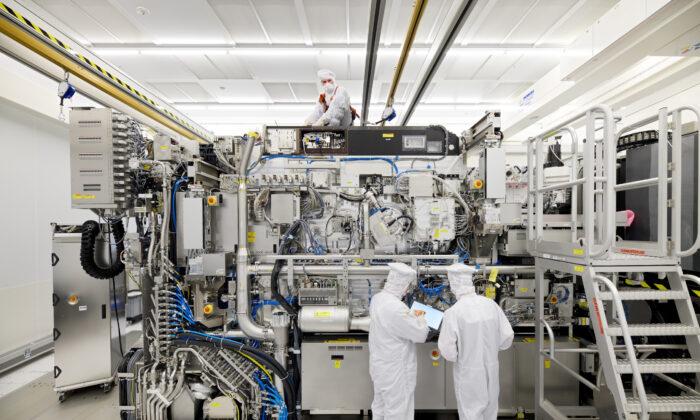Major computer chip makers are facing a critical shortage of manufacturing equipment for the second year in a row as they attempt to increase production in the middle of a supply chain crisis.
A global shortage has been causing problems for many chip-reliant industries since the waning of the initial COVID-19 pandemic, with manufacturers struggling to catch up with surging demand.
“Next year and the year after there will be shortages,” he said. “We’re going to ship more machines this year than last year and ... more machines next year than this year. But it will not be enough if we look at the demand curve. We really need to step up our capacity significantly more than 50 percent. That will take time.”
ASML’s machines are used to etch circuits into silicon wafers in the manner of a printing press, Richard Windsor, tech analyst at Radio Free Mobile, told Financial Times, making the company’s products critical to the semiconductor supply chain.
The world’s major chip makers—Taiwan Semiconductor Manufacturing Company Ltd., Intel Corp., and Samsung Electronics—all rely on ASML’s lithography machines.
ASML’s near-monopoly on lithography systems generates stable revenue growth for the company. Global sales of semiconductors soared to a record $556 billion in 2021, up more than 26 percent year-over-year, according to the Semiconductor Industry Association.
But as lockdown measures eased and consumer activity increased with the reopening of the economy, it has been difficult for supply chains to catch up.
The rise in demand contributed to initial growth in the semiconductor industry in the first half of 2021, but shortages and supply chain disruptions limited the recovery in the second half of the year.
The semiconductor industry has increased its investments in new production lines to meet the global shortage of chips.
ASML said it was working with its suppliers to increase production capacity. The chip equipment manufacturer has 700 product-related suppliers, of which 200 are critical, but it is not clear how much in investments should be made, said Wennink.
The United States and Europe are planning to invest billions in support for chip manufacturing in an attempt to reduce their reliance on Asian manufacturers, and analysts estimate that the semiconductor market will double and reach $1 trillion by 2030.
Intel Corp., the American chip maker, said that it would invest roughly $36.5 billion in manufacturing and research in Europe, which will rise to $88.35 billion by 2030, depending on demand.
The company has plans to invest $40 billion to expand chip manufacturing domestically in an effort to catch up with the industry leader, TSMC, in Taiwan, which is investing more than $100 billion in expansion plans over the next three years.
Intel CEO Pat Gelsinger told Financial Times that the equipment shortage posed a challenge for the company’s expansion plans.
South Korean company Samsung Electronics has said it will invest $150 billion by the end of the decade to expand production, part of an estimated $421 billion project involving more than 150 South Korean companies, according to the South Korean government in Seoul.
Gelsinger told Financial Times he had been in direct contact with Wennink regarding the shortages and that Intel sent its own manufacturing specialists to ASML to help expedite production.
“Today this is a constraint,” Gelsinger said, adding that he believes there is still time to resolve the shortages issue.
It would take at least two years to build a new chip factory and another two years to fill the building with the necessary equipment, he said.
Wennink said he agreed with Gelsinger’s assessment of the situation, but stressed that ASML’s own suppliers would need to boost their production first to meet increased demand, as new manufacturing facilities are not expected to come online before 2024.
ASML is also dealing with the shortage of neon gas, which is “used in small quantities for the gas-phase lasers in its DUV systems,” Nasdaq reported. The current conflict in Ukraine has severely disrupted the global supply of neon gas from Russia and Ukraine.
Ukraine is the world’s largest producer of neon gas, and ASML receives a fifth of its supply from Ukraine and Russia.
The Dutch company said it has been searching for alternative sources of neon in an effort to stabilize supplies, but “the soaring price of the gas could squeeze its gross margins unless the conflict subsides,” Nasdaq reported.





